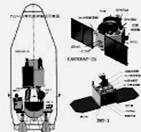
As we know, it is not easy to build a satellite. Building a traditional satellite normally takes years. The
costs can be as high as $ 250 million or more. Most members of the design teams have worked in the field
for a long time. They hold advanced degrees in math, science, or engineering.
But things are changing. High costs, unusual educational requirements and long start-up times are no
longer an
obstacle to space exploration. The scientists at Stanford University have developed a new type of
tiny, inexpensive earth-orbiting satellites that go from ideas to launch (發射) in a year.
So far, college students have built and launched several cube-shaped satellites, or Cube Sats. At least 15
more are ready to go. Those already in orbit (軌道) take pictures, collect information. and send it back to the
earth, just as regular satellites do.
But you might not even have to wait until you get to college to start designing and building your own
satellite. A new program called Katy Sat aims to get teenagers to take part. Once kids understand and what
satellites can do, says Ben Yuan, an engineer at Lockheed Martin in Menlo Park, Calif, the kinds of applications
they'll come up with may be countless.
"We'd like to put this technology (技術) in your hands," he tells kids." We're going to teach you how to
operate a satellite. Then we want to turn it over to you as a sandbox for you to play in. We want you to take
the technology into new directions that we haven't though of yet."
Education isn't the only goal of Cube Sats. Because these tiny, technology-filled boxes are relatively
inexpensive to build and can be put together quickly, they're perfect for testing new technologies that might
one day be used on major space tasks.
The biggest challenge now is to find ways to bring the satellites back to the earth after a year or two.
Otherwise, major highways of space junk could gradually increase as CubeSats become more common.
Nowadays, college and high school students are getting a chance to learn what it takes to explore in space.
Someday-perhaps a lot sooner than you imagine-you might get to design, build and launch your own satellite.
If you do, you're sure to have fun. And you might also get crazy a-bout science for life.
1. Compared with the traditional ones, the new satellites ______.
A. need long start-up times
B. are low-cost and small-sized
C. are very hard to operate
D. collect more information in orbit
2. What does the underlined word "obstacle" probably mean?
A. An aim to achieve in the near future.
B. An imagination that kids usually have.
C. Something dangerous to terrify people.
D. Something difficult that stands in the way.
3. According to the passage, which of the following is true?
A. CubeSats could possible cause pollution in space.
B. A few kids will send applications for the project.
C. Scientists designed CubeSats for kids to play with
D. Students can't design satellites without college education.
4. What's the purpose of the author writing the passage?
A. To show that high technology brings a big change in kids' life.
B. To show that kids lead the space research into a new direction.
C. To tell us that satellite technology can also be learned by kids.
D. To tell us that kids must study hard to learn satellite technology.


